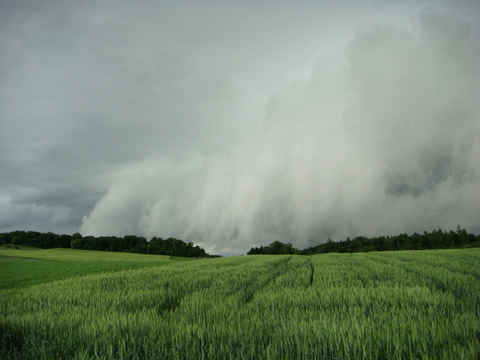« Reading List: The Dumbest Generation |
Main
| Crossing the Road, Very Slowly »
Wednesday, June 4, 2008
Keep Your Podder Dry
Last Monday afternoon, (June 2nd, 2008), I had the unanticipated and unpleasant experience of “water testing” a variety of gizmos I carry on my daily walks. (And yes, I wish they were all integrated into one. Patience—it will happen.) I set out under dark and threatening skies, but the
radar map showed no precipitation in the region (as of the time it was posted, which is usually within a half hour of the present), so I decided to brave the elements.
I chose unwisely.
About 20 minutes out, a high wind began to drive a menacing fog/cloud layer in my direction. This picture (click the image for an enlargement) does not begin to convey how ugly this looked as it swept in from the southwest as fast as a locomotive.

About a minute after this picture was taken, heavy rain began to fall, and a few seconds later, intense hail. The hailstones were not big—about 3–4 mm—but as they landed on my sparsely thatched cranium it sounded like 35 crazed monkeys whacking on it with spoons. Also, it
hurt, especially as the hail was driven by high winds. Just to make things even more delightful, the rain continued to accompany this, and fog reduced visibility to about 10 metres.
Given that just the day before I'd happened across a picture of
really serious hail, it occurred to me that given how these tiddler hailstones were pummeling me, if something like that started to come down, this could end badly. So, I made my way about 500 metres further down the trail where I could duck into a conifer forest. The hail continued to fall, but with its fall broken by the trees and the wind attenuated by them, it didn't
thwock the skull or sting the skin.
As such things tend to go, after about 10 minutes the hail let up, and I decided to head back, knowing that if it returned there were ample opportunities to seek shelter along the way, as there was forest along much of the return path and soon I'd be back in the
village. It continued to rain heavily all this time, and I had long since been as completely soaked as if I'd jumped into the
Fourmilab pool.
All this time I had continued to listen to an
audiobook on the iPod Nano (2nd generation, model MA497). About 15 minutes after the turn-around point, it
quit, and the iPod went completely dead. When I got back, I discovered the iPod totally nonresponsive to all of the buttons, and figuring that water had gotten into it, put it on the top of an LCD monitor (where the backlight generates mild heat) to dry out. I further discovered that the Palm Treo 650 mobile phone/PDA was also dead, so I removed the battery and placed it on the top of the monitor as well. I was also carrying a Sony DSC-T200 digital camera and a Garmin 60CSx GPS at the time (the latter not because I don't know the countryside, but to serve as a space asset based pedometer); both came through the drenching with no problems whatsoever.
Over the next few hours, the iPod did all kinds of crazy things: it would randomly make selections, start and stop playing things, and the like. First the centre selection button started to work, then the peripheral buttons came back, but for a long time the click wheel was out of action. It did not come back into operation until about eight hours of drying out. The LCD screen appeared “mottled”—my guess is a thin layer of water between the screen and the window of the case. This slowly dissipated over the next two days. So far, I have noted no permanent damage from the episode.
The Treo also recovered in phases. After about an hour, it would power up when I inserted the battery, but power back down immediately after the start-up sequence. A few hours later, it would go into an endless reboot loop. Finally, the day after, everything appeared to be fine and it's worked OK ever since. The databases stored on the handheld were preserved across the drenching.
Now, I certainly don't expect consumer electronics to survive what amounts to immersion in water: that, among other hardening against environmental vicissitudes, is why MIL-SPEC gear costs so much! Nor did I set out that day to subject either myself nor the gadgets on board to such abuse. I'm simply reporting this experience as a data point. If you're heading into conditions where you may get very, very wet, either due to weather or
other reasons, it's an excellent idea to pack a plastic bag to shield your electronics from the elements when things get dank and drippy. And also, based upon a whole
two data points (hey, it's enough to draw a line!), dunking in fresh water is not necessarily fatal to consumer electronics if they're allowed to dry out gently over a period of time.
Posted at June 4, 2008 23:01
